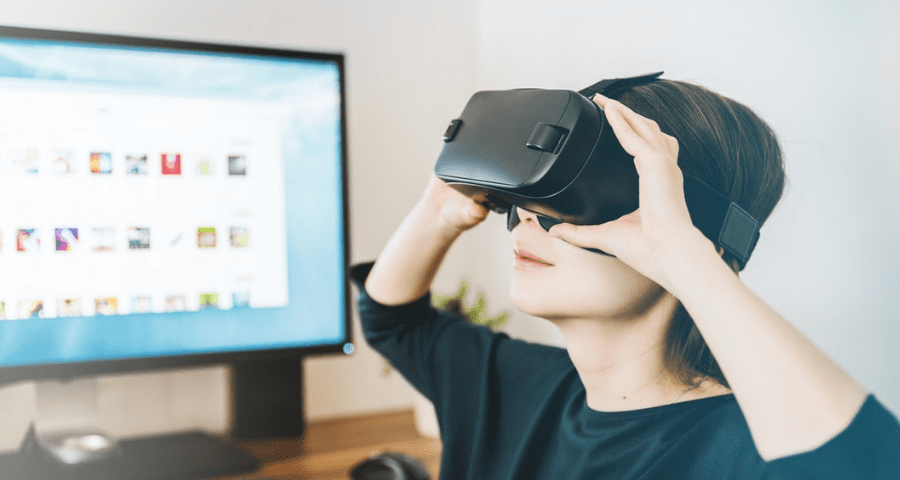Teaching Vocabulary to English Language Learners with AR
Curiosity is the crucial element in our DNA which drives us to explore and learn. From ancient times until now, we, as human beings have always wanted to try things for ourselves, to explore and experience. I believe that learners should be given the opportunity to explore the things they are learning. In-class environments are not always able to provide these opportunities but language teachers can overcome this obstacle by bringing traditional (dead) course books to life and employing Augmented Reality technology which is relatively easy.
Vocabulary Teaching Strategies for English Learners
Technology is changing the brains of adolescents
The children of today are bombarded with technological tools from the day they are born and there are even some studies which have discovered that the brain structure of today’s children is not the same was that of previous generations. Early results from a $300 million study funded by the National Institute of Health have shown that smartphones, tablets, and video games are physically changing the brains of adolescents (Lisdahl et al., 2018). Prensky (2001), nearly twenty years ago, highlighted the characteristics of today’s children by stating “Our students have changed radically and today’s students are no longer the people our educational system was designed to teach” (p.1).
Quizlet for Vocabulary Teaching
How can we engage our students?
He further emphasized that students spend their entire lives with mobile phones, computers, video games, music players and video cams. How can we as teachers engage our students if we are not on the same wavelength? The gap between teachers’ technological skills and knowledge and that of students’ is widening. Thus, teaching increasingly demands technologically-competent and efficient teachers who can capture the attention of digital natives and in order to be able to do this, teachers need to be one step ah….no! Two steps ahead of their students if that is at all possible.
Technology has affected how we learn languages
Ahmad (2012) stated that in the millennial age, media technologies such as pictures, videos, conferencing, animation-creation, computer games, chat rooms and social networking sites ranging from Penpals to Facebook have affected the way we learn and teach languages. With such tools, learners now have endless opportunities to learn languages and he further stated that these technologies have made language learning and teaching more enjoyable and productive (Ahmad, 2012).
Best Technology for English Teachers
These new technologies have also paved the way for a change in course delivery and new approaches in course delivery have emerged with technological advancements (Barrett et al.,2002). For instance, Simsek and Can (2015) delivered a departmental course in a virtual world game called Second Life.
Virtual Reality is an emerging technology that immerses the user in a completely different environment with the help of VR glasses or headsets (Moore, 1995).
Once they put VR glasses or headsets on, they switch to a computer-generated environment. Students might visit an airport in a virtual world and practise airport English or a French learner might pay a visit to a café in Paris and order a croissant. ImmerseMe is an online platform that offers such situational learning contexts for learning languages in Virtual Reality.
How to Teach Speaking to Upper-Intermediate Students
Augmented and virtual reality
People generally confuse the terms augmented and virtual reality, thus, a distinction needs to be made. Azuma (1997) defined this distinction by saying “AR supplements reality, rather than completely replacing it” (p.2). Augmented Reality technology adds virtual objects such as 3D objects, video, pictures or sound into your real life environment on a mobile device screen while Virtual Reality places the user in a computer-generated environment. AR has been found to offer great advantages for language learning, namely, motivation, academic success, increased interaction, increased collaboration, higher retention of knowledge,.
AR is an extraordinary instructional tool
With its feature of visualizing the content in a context-rich environment, AR provides students with “meaningful associations between the content and the real environment” that eventually eases the process of vocabulary learning (Santos et al., 2016, p.6). Augmented Reality simulations might provide language learners with motivating experiences and unexpected delight (Taskiran, 2018). Media components such as audio, video, animation and interactivity facilitate language learning by reducing anxiety (Hwang & Huang, 2010).
Check out more articles on teaching vocabulary
Augmented Reality is an extraordinary instructional tool furnishing teachers with opportunities to create, personalize and more authentic, engaging and interactive learning experiences (Wang et al., 2017). AR has been utilized for every language skill; speaking and listening (Liu, 2016), writing (Yılmaz & Goktas, 2016), reading (Tobar-Muñoz, Baldiris, & Fabregat, 2017) and letter recognition for the pre-literacy stage (Majid, Arshad, & Yunus, 2018).
It is suggested that in the future, standard textbooks would be AR-enhanced, with 3D graphics and information pop-ups (Chou & Chanlin, 2012).

Vocabulary teaching is very suitable for AR technology. With the collaboration of my pre-service English teachers, we transformed a traditional course book unit related to animals into an Augmented Reality enhanced coursebook. Learners were able to bring these animals into life by employing various AR application such as HPReveal, Augment, BlippAR, ZAPWorks, UniteAR, Holo and LayAR.
One of my preservice English teachers wrote in her blog that:
With these apps, I can create effective and attractive activities or games which will make my students more successful and motivated. As a future teacher, AR technology can be so helpful for teaching a subject. I can integrate AR technology into my classrooms for some reasons, such as motivation and success. In addition, in some areas, such as vocabulary and oral communication skills. Briefly, AR technology should be integrated into the classroom to provide an efficient learning process.
CAhsen Denizer, Pre-service English Teacher

It is even possible to add a related video on a specific area of the course book, thus supporting self-paced learning. When I and my preservice teachers tried this technology in our own classes, we observed that students were really amazed and attracted by it, since they didn’t feel like they were covering a lesson, but felt like they were at home and playing games. Moreover, this time, they had a chance to explore the target information in a more detailed way and in his or her own field of vision. Below is an anecdote shared by one of my preservice teachers who experimented with his in her own class.
“I want to share my own experience, as well. I have tried augmented reality with my students. It caught their attention pretty much and they learned vocabulary items so easily with this technology. I am going to use AR technology from this day forth to make the learning process more meaningful and effective for my students. My final thought is that augmented reality is a living tool, we can do things beyond what we think.”
Furthermore, this was something students hadn’t experienced before and they perceived their teachers as someone ahead of them. This leads to greater attention in the class. Studies conducted concerning this suggest that AR is an attention-raising tool for learners ( Kirkley & Kirkley, 2005; Stapleton, Smith, & Hughes, 2005). Surprisingly, AR is also reported to raise the attention of students who are even struggling with attention deficit hyperactive disorder (Aziz et al., 2012).
The possibilities are endless with this technology. Lesson plans can easily be developed around AR. For instance, when an animated animal is on the phone screen, students can be asked to give a name to it, pet it and tell a story about a day in its life or students might talk as if they were these animals. Movements of animals can be told with references to tenses. In a discussion we had on AR, we were able to come up with more than two dozen ideas in just one hour.
In conclusion, it is incredibly easy to create AR experiences for your students regardless of what their levels are. There are dozens of ready-to-go applications in the Google Play Store or Apple App Store along with hundreds of tutorial videos that show how to implement AR in classes step by step.
From my own and my preservice teachers’ experiences, I can clearly state that it is an astonishing feeling to see a young learner go “wow!” in the class. At the end, of the day, isn’t it why we are there? Arousing curiosity to learn and paving the way for exploring more…
References
- Ab Aziz, N. A., Ab Aziz, K., Paul, A., Yusof, A. M., & Noor, N. S. M. (2012, February). Providing augmented reality-based education for students with attention deficit hyperactive disorder via cloud computing: Its advantages. In Advanced Communication Technology (ICACT), 2012 14th International Conference on (pp. 577-581). IEEE.
- Chou, T., & ChanLin, L. (2012). Augmented Reality Smartphone Environment Orientation Application: A Case Study of the Fu-Jen University Mobile Campus Touring System. Procedia – Social and Behavioral Sciences, 46, 410-416. doi:10.1016/j.sbspro.2012.05.132
- Chou, T., & ChanLin, L. (2012). Augmented Reality Smartphone Environment Orientation Application: A Case Study of the Fu-Jen University Mobile Campus Touring System. Procedia – Social and Behavioral Sciences, 46, 410-416. doi:10.1016/j.sbspro.2012.05.132
- Hsu, H., Wenting, Z., & Hughes, J. E. (2018). Developing Elementary Students’ Digital Literacy Through Augmented Reality Creation: Insights From a Longitudinal Analysis of Questionnaires, Interviews, and Projects. Journal of Educational Computing Research, 073563311879451. doi:10.1177/0735633118794515
-
Hwang, Y., & Huang, N. P. (2010).A Study of EFL College Students’ Language Anxiety in Multimedia Environments. The International Journal of the Humanities: Annual Review, 8(2), 367-378. doi:10.18848/1447-9508/cgp/v08i02/42860
- Kirkley, S. E., & Kirkley, J. R. (2005). Creating next generation blended learning environments using mixed reality, Video Games and Simulations. TechTrends, 49(3), 42-53. doi:10.1007/bf02763646
- Küçük, S., Yilmaz, R., & Göktaş, Y. (2014). Augmented Reality for Learning English: Achievement, Attitude and Cognitive Load Levels of Students. TED Eğitim ve Bilim, 39(176). doi:10.15390/eb.2014.3595
- Lisdahl, K. M., Sher, K. J., Conway, K. P., Gonzalez, R., Ewing, S. W. F., Nixon, S. J., & Heitzeg, M. (2018). Adolescent brain cognitive development (ABCD) study: overview of substance use assessment methods. Developmental cognitive neuroscience, 32, 80-96.
- Majid, N. A. A., Arshad, H., & Yunus, F. (2018). Children And Teacher’s Interaction For English Pre-Literacy Using Mobile Augmented Reality. International Journal, 3(15), 71-78.
- Moore, P. (1995). Learning and teaching in virtual worlds: Implications of virtual reality for education. Australasian Journal of Educational Technology, 11(2).
- Santos, M. E., Lübke, A. I., Taketomi, T., Yamamoto, G., Rodrigo, M. M., Sandor, C., & Kato, H. (2016). Augmented reality as multimedia: the case for situated vocabulary learning. Research and Practice in Technology Enhanced Learning, 11(1). doi:10.1186/s41039-016-0028-2
- Simsek, I., & Tuncer, C. A. N. (2015, March). The design and use of educational games in 3D virtual worlds. In Society for Information Technology & Teacher Education International Conference (pp. 611-617). Association for the Advancement of Computing in Education (AACE).
- T. Azuma, Ronald. (1996). A Survey of Augmented Reality. Presence: Teleoperators and Virtual Environments. 6. 10.1162/pres.1997.6.4.355.
- Taskiran, A. (2018). Augmented Reality Games and Motivation in Language Learning. In EdMedia+ Innovate Learning (pp. 892-898). Association for the Advancement of Computing in Education (AACE).
- Tobar-Muñoz, H., Baldiris, S., & Fabregat, R. (2017). Augmented Reality Game-Based Learning: Enriching Students’ Experience During Reading Comprehension Activities. Journal of Educational Computing Research, 55(7), 901-936. doi:10.1177/0735633116689789
- Wang, Y. (2017). Exploring the effectiveness of integrating augmented reality-based materials to support writing activities. Computers & Education, 113, 162-176. doi:10.1016/j.compedu.2017.04.013







4 Responses
Cemil Gökhan Karacan
These are some great points, thank you for your comment.
14/06/2021
Cemil Gökhan Karacan
These are some great points, thank you for your comment.
14/06/2021